
Astrolabe
Unsigned
Late 16th century; Flemish
Brass; 281 mm in diameter
The mater has the limb riveted to the back plate, shaped and pierced throne, shackle and suspension ring. The throne is held by 2 securing screws and a locating pin. The limb has an outer scale of hours marked with Roman numerals, 0 to 12 twice, divided to 1 hour, subdivided to 30 and to 15 minutes, numbered by 1 hour. Inside the mater is a 'QVADRATVM NAVTICVM', comprising a square with latitude and longitude scales, one on each half side, 0 to 90 degrees, divided to 10, subdivided to 2, numbered by 10, marked 'Longitudo Orientalis', 'Latitudo Borealis', &c. Latitude and longitude lines cross the square at 30-degree intervals. The cardinal points are marked 'SEPTENTRIO', 'ORIENS', 'MERIDIES' and 'OCCIDENS'. A circle inscribed in the square has names and directions of 32 winds: 'APARCTIAS', 'HYPERBOREUS', 'Boreas', 'Mesoboreas', 'Arctapeliotes', etc.Three plates for latitudes 42? and 43?, 44? and 45?, and 46 and 48, with azimuths for every 3 degrees, numbered by 15, and almucantars for every degree, numbered by 10. Meridian and east-west line ('Horizon rectus'), circles for the tropics ('Tropicus Cancri', 'Tropicus Capricorni') and equator ('?quinoctialis'), crepuscular line ('LINEA AVROR?'). The horizon is marked 'Horizon obliquus'. Beneath the horizon are lines of unequal hours, with Roman numerals; lines for the houses of heaven are numbered 1 to 12. Rete of the Arsenius type for 48 named stars, the ecliptic circle with the names and symbols of the signs, each with a scale of 30 degrees, divided to 10, subdivided to 5 and to 1, numbered by 10. The back has a an outer degree scale 90 to 0 to 90 to 0 to 90, divided to 10, subdivided to 5, to 1 and to 1/2, numbered by 10. Inside this is a zodiacal scale with names and symbols of the signs, each with a 30-degree scale using the same divisions as the outer scale. Inside this is a calendar scale with the month names in Latin, each with a scale of days. divided to 10, subdivided to 1, numbered by 10 as appropriate; December is given 311/4 days. The first point of Aries is at 21 March. The upper half of the central area has a conversion diagram for equal and unequal hours, the semicircular scale of 'HOR? IN?: QVA: LES.' 1 to 12, divided to 1 hour, subdivided to 20 minutes and to 4 minutes, numbered by 1 hour, the lines got every hour and half-hour (marked by arrows) numbered by 1. One quadrant is marked 'Hor? ante meridiem', the other 'Hor? post meridiem'. The lower half has a double shadow square with scales 0 to 12 to 0 to 12 to 0, divided to 0.2, numbered by 1. The same scales are also marked 0 to 60 to 0 to 60 to 0, and are marked 'VMBRA VERSA', 'VMBRA RECTA', 'VMBRA RECTA', 'VMBRA VERSA'. Counterchanges alidade with shaped ends, vanes with double pinhole sights, and a scale on each arm, 'Hor? ortus Solis', 0 to 10, subdivided to 1/2 and to 1/4, numbered by 1, and 'Hor? occasus Solis', 0 to 12, subdivided to 1/2 and to 1/4, numbered by 1. Screw, washer and shaped nut. Jim Bennett
Museum of the History of Science, Oxford
Inventory number 45365
© Museum of the History of Science, Oxford. All rights reserved. Information and images provided here may not be reproduced in any form or by any means without the prior written permission of the museum.
Basic URL: http://www.mhs.ox.ac.uk/epact/catalogue.php?ENumber=21983 |


